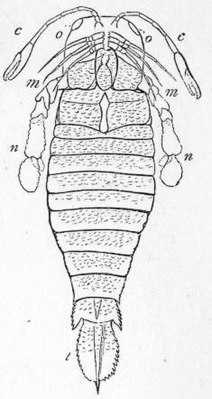Pterygotus
| Pterygotus | ||||||||||
|---|---|---|---|---|---|---|---|---|---|---|

Pterygotus anglicus |
||||||||||
| Temporal occurrence | ||||||||||
| Silurian to Devonian | ||||||||||
| 439 to 360.7 million years | ||||||||||
| Locations | ||||||||||
| Systematics | ||||||||||
|
||||||||||
| Scientific name | ||||||||||
| Pterygotus | ||||||||||
| Agassiz , 1844 |
Pterygotus was a sea scorpion livingin the Silurian and Devonian . It is the second largest Eurypterid found to date and one of the largest known arthropods of all time. It could reach a length of about eight feet.
body
Appearance
Outwardly, Pterygotus looked like other species of sea scorpions widespread in the Silurian. It had four eyes , two enormous reticulated eyes and two smaller eyes in the middle of the head. Six pairs of body appendages were used for locomotion and food acquisition: four normal pairs of legs in the middle, two "oar feet" behind and in front of large claws, which were similar to the claws of the lobster .
Body structure
As with all sea scorpions, the body of Pterygotus was divided into two parts. The jawless mouth, the two pairs of eyes and the twelve legs were located on the Prosoma shield . The abdomen (called the opisthosoma), consisting of twelve segments, carried the genital organs as well as the respiratory organs. The larger pair of eyes indicate that Pterygotus was arguably a visually oriented predator. The tail (telson) formed a large rudder with which it could probably accelerate. In related species, scissors or a sting had also formed.
Way of life
habitat
Pterygotus lived in the Upper Silurian seas, which were filled with rich life . He preferred rather shallow waters. Remains were found in Europe and North America that were still connected at the time. The southern continents then formed the supercontinent Gondwana . Pterygotus lived mostly on and in the sandy seabed, but his primitive lungs allowed him to go ashore for a short time, even though he was so large. However, unlike the smaller sea scorpions (such as Megalograptus ), it could not leave the sea to reproduce or breed. Pterygotus could also live in fresh water. Presumably he dodged lakes and rivers to catch fish. Pterygotus was probably a skilled swimmer and could move quickly and nimbly through the water. It probably swam by moving its long, flat tail down and up. The wide, flat portion at the end of its tail drove it through the water like a whale's tail fluke . He steered and stabilized himself using his legs.
nutrition
Sea scorpions ruled the seas in the Silurian, fish were not yet much competition , but food. Sharks hadn't evolved yet. Pterygotus was at the top of the food chain . He chased probably from the ambush by in the sand burying or plants hidden. Like some other carnivores, it ate carrion .
Systematics
Pterygotus was related to the larger Jaekelopterus and the little-known freshwater genus Slimonia . These extinct creatures are also counted to the group of sea scorpions within the Merostomata . Of the latter group are rezent only the horseshoe crabs available.
Forty different species have been found so far from the closer relationship of Pterygotus , the Pterygotidae. These species are found all over the world , with the exception of Antarctica . There are relatively many fossils of him, but complete skeletons are relatively rare. Pterygotidae lived from the Ordovician to the Devonian. Narrow to long skin armor with crescent-shaped scales were characteristic. The epidermis was thin with remnants of very large body segments (tergites and sternites), preserved as a paper-thin compression. A comparable lightweight construction was recently postulated for the arthropleura . The telson was wide and very flat. Pterygotidae had large claws with sharp, well-developed teeth in front of the head. The legs were slender, without thorns. Pterygotus differs from the other Pterygotidae by the curved outer edge of the scissors ( chelae ). The prosoma is subtraperisoidal (trapezoidal with rounded corners) with a pronounced dorsal keel fin that ended in a short spine.
Pterygotus was one of the first, gigantic sea scorpion species, the following ones were smaller and weaker. Presumably because of their relative slowness and their vulnerability, which prevented them from escaping ashore like the smaller sea scorpions, they were the prey of large, fish-like placodermi such. B. the Dunkleosteus . The population of large sea scorpions decreased in Devon .
swell
Individual evidence
- ↑ a b SJ Braddy, M. Poschmann, OE Tetlie: Giant claw reveals the largest ever arthropod. In: Biology letters. Volume 4, number 1, February 2008, pp. 106-109, doi : 10.1098 / rsbl.2007.0491 , PMID 18029297 , PMC 2412931 (free full text).
literature
- Lexicon of dinosaurs and other prehistoric animals Dorling Kindersley, 2001, pp. 26, 27
- Otto Jaekel: A large pterygotus from the Rhenish Lower Devonian. Paläontologische Zeitschrift, 1, 1, pp. 379-382, 1914
Web links
- Pterygotus: Silurian Sea Scorpion
- The Paleobiology Database Pterygotus